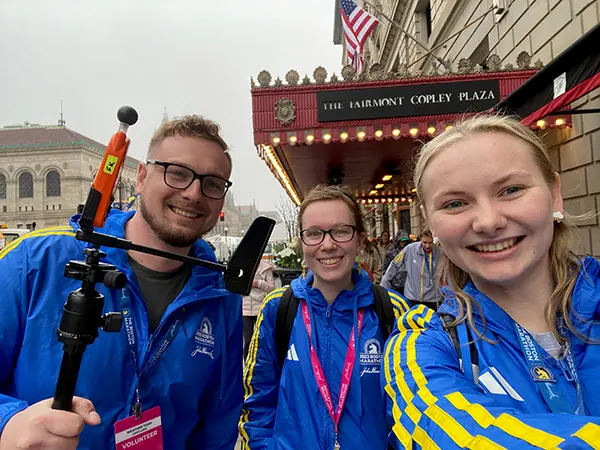Students’ Weather Observations Assist Race Officials, Medical Teams and Media
 Image by Nicole McClung
Image by Nicole McClung
04/21/2023
By Brooke Coupal
Along the route of the 127th Boston Marathon, amid the throngs of spectators and volunteers, UMass Lowell meteorology students collected weather observations in real time.
Their observations served a dual purpose: to help officials prepare for weather-related injuries and to assist the media in reporting accurately.
“The weather conditions make a big difference, especially on a course like the Boston Marathon, which does not start and end in the same place,” says Environmental, Earth and Atmospheric Sciences Prof. Frank Colby, who has been supervising weather-monitoring students at the marathon since 2012.
Equipped with hand-held meteorological instruments, 12 students collected measurements every 15 minutes for temperature, relative humidity, dew point and wind speed and direction.
 Image by Amanda Joly
Image by Amanda Joly
“At our location, the temperature was steady almost the entire time, around 54 degrees Fahrenheit,” says junior Joshua Polen, who was stationed in Newton with junior Amanda Joly. “We had occasional drizzle and showers, with overcast skies throughout. The wind was also minimal, being calm at 0 mph for most observations.”
The students also recorded the wet bulb globe temperature, which Colby says is effective for monitoring the health of the athletes.
“It’s a compound composite of temperature, relative humidity and solar radiation,” Colby says. “It keeps track of how well the body is able to perspire and control its temperature.”
This measurement allows the medical teams to prepare for major weather-related health emergencies like heat stroke or hypothermia.
“Our data is incredibly valuable for the runners, medical teams and spectators in case of extreme weather,” says master’s student Ali Fallah, who made observations with master’s student Troy King in Brookline.
When students along the course recorded their weather measurements, they texted the information to either Colby, junior Nicole McClung or master’s student Alexis McKenzie, who were all stationed at the media center at the Fairmont Copley Plaza in Boston. The group shared the data with members of the media at the center and uploaded it into a Google Sheet accessible by the Boston Athletic Association medical teams and the Massachusetts Emergency Management Agency (MEMA). Michael Souza ’13, ’14, a double River Hawk who works at MEMA as the agency’s meteorologist, created and oversaw the spreadsheet.
“It’s a big operation, and UMass Lowell is a huge part of it because actual weather observations in the field are a lot better than any kind of weather model values,” says Souza, who also monitored weather conditions along the course when he was a UML student.
 Image by MEMA
Image by MEMA
Senior Madison Young shadowed Souza at MEMA’s headquarters in Framingham during this year’s marathon. Her role involved making sure the data MEMA received was entered correctly into the spreadsheet. She also participated in MEMA briefings and ended up meeting Gov. Maura Healey.
“I learned a lot by observing a professional meteorologist working in the field and was able to ask a lot of questions,” she says. “I feel this opportunity opened a lot of doors for me in terms of networking and meeting other meteorologists.”
McClung, who spent most of the day in the media center, took a moment to go to the finish line to take some weather readings herself.
“I was able to learn how great of an impact our measurements can actually have in a real-life situation,” she says.
With this marathon marking 10 years since the 2013 Boston Marathon bombings, McClung also made sure to stop at the nearby memorial that honors the victims of that tragic day.
“To actually see the memorial in person at the finish line was very heartbreaking,” she says.
 Image by Ali Fallah
Image by Ali Fallah
Colby had been working in the media center on April 15, 2013, as it was the second year UML students had volunteered to make weather observations.
“We had two students who were across the street from where one of the bombs went off,” he recalls. “They just dropped everything and ran all the way to one of their houses just north of Boston.”
Colby and the 15 students who helped monitor the weather that day were not physically harmed, and despite their fears, they returned a year later to continue making weather observations.
“Everybody felt that we should not forget what happened, but also not let it control our lives,” he says. “I think that says something about the spirit of Americans, especially in Boston.”
For Polen, volunteering at the Boston Marathon 10 years after the bombings was an eye-opening experience.
“Seeing the 30,000-plus runners pass just showed how resilient and strong us Bostonians are,” he says, “and that we refuse to allow a senseless attack get in the way of our traditions.”
